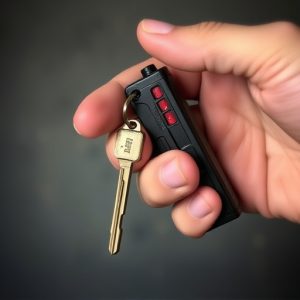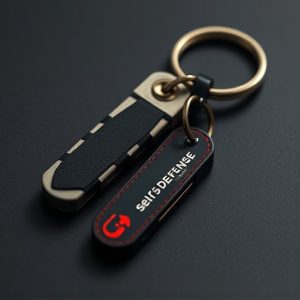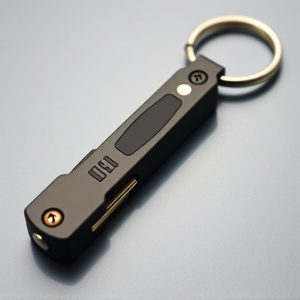Legal Self-Defense Keychain: Concealment Design & Regulations Explained
In regions with varying self-defense keychain laws, understanding Legal Self Defense Keychain Regula…….
In regions with varying self-defense keychain laws, understanding Legal Self Defense Keychain Regulations is crucial for compliance and personal safety. These regulations dictate weapon types, carry permissions, age limits, and required permits. Designing a secure pocket clip requires adhering to these rules, using robust materials like stainless steel, and complying with regional laws on knife lengths and hidden carry permits. Ergonomics ensure comfort and quick access, while navigating legal restrictions fosters innovation in compact, powerful keychains for effective self-defense without compromising safety or legality.
In today’s world, personal safety is a top priority. For those seeking legal self-defense options, keychain weapon concealment offers a discreet yet effective solution. This article delves into the intricate details of designing a secure pocket clip for legal self-defense keychains, navigating the complex landscape of Legal Self Defense Keychain Regulations. From understanding crucial legal considerations to exploring innovative materials and market trends, we’ll uncover the key components ensuring a successful and safe concealment design.
- Understanding Legal Self-Defense Keychain Regulations
- Key Components of a Secure Pocket Clip Design
- Materials and Manufacturing Considerations for Concealment
- Ergonomics and User Experience in Weapon Concealment
- Market Trends and Innovations in Legal Self-Defense Keychain Designs
Understanding Legal Self-Defense Keychain Regulations
In many regions, the legal framework surrounding self-defense and weapon possession is stringent, especially when it comes to small arms like keychains with concealed blades or other sharp objects. Understanding these Legal Self-Defense Keychain Regulations is paramount for anyone considering carrying such a device as a means of personal safety. The laws vary greatly from one jurisdiction to another, so it’s crucial to check local and state regulations before purchasing or carrying any self-defense keychain.
These regulations often cover aspects like the type of weapon allowed, public versus private carry, minimum age requirements, and any necessary permits or licenses. Some locations may also have restrictions on the length, lock mechanism, or design of the keychain blade to ensure it doesn’t meet the definition of a full-sized firearm or knife. Staying informed about these Legal Self-Defense Keychain Regulations not only helps individuals avoid legal repercussions but also ensures they can effectively protect themselves while adhering to the law.
Key Components of a Secure Pocket Clip Design
When designing a keychain weapon concealment pocket clip, several key components contribute to its overall security and legality in the context of self-defense. One of the most crucial aspects is the attachment mechanism. The pocket clip should securely fasten to your clothing or belt, utilizing strong materials like stainless steel or high-quality metal alloys. This ensures the weapon remains concealed yet readily accessible when needed for self-defense.
Moreover, the design must consider legal regulations surrounding self-defense keychain weapons. Different regions have varying laws regarding hidden carry permits and restrictions on knife lengths and carrying methods. A well-designed pocket clip should be adaptable to these regulations, offering a simple yet secure way to attach your defense tool while adhering to local legal requirements for legal self-defense keychain use.
Materials and Manufacturing Considerations for Concealment
When designing a keychain weapon concealment pocket clip, materials and manufacturing processes are crucial aspects that impact both functionality and legality. High-quality materials like stainless steel or titanium offer durability and resistance to everyday wear and tear, ensuring the keychain’s longevity. These metals also provide a solid foundation for precise manufacturing techniques, allowing for intricate designs that balance strength with discreetness.
Manufacturing considerations must adhere to legal self-defense keychain regulations. Strict compliance ensures the product remains compliant across various jurisdictions. Advanced machining and injection molding technologies enable precise shaping and texturing, enhancing grip and concealment capabilities. Additionally, these processes allow for subtle features that can provide a tactical advantage while maintaining an unassuming appearance, catering to users seeking both protection and discretion.
Ergonomics and User Experience in Weapon Concealment
Ergonomics and user experience are key considerations in designing a keychain weapon concealment pocket clip. The comfort and ease of use can significantly impact how effectively a self-defense tool can be deployed in a real-life situation. A well-designed clip should fit comfortably in the hand, allowing for a firm grip and quick access to the weapon. This is particularly important when dealing with legal self-defense keychain regulations, which vary across jurisdictions.
The pocket clip must seamlessly integrate with everyday carry items like wallets or bags without causing discomfort or awkwardness. Smooth operation and minimal bulk ensure the user can reach for their defense tool instinctively and discreetly. Understanding local laws regarding concealed weapon carry is crucial; many regions have specific requirements for such devices, focusing on safety, legal self-defense, and prevention of accidental discharge to protect users and bystanders alike.
Market Trends and Innovations in Legal Self-Defense Keychain Designs
The market for legal self-defense keychain designs has seen a surge in innovation, driven by growing consumer demand and varying regional regulations. One prominent trend is the integration of advanced materials and engineering to create smaller, more discrete weapons that still pack a punch. Manufacturers are leveraging modern metallurgy to design compact yet robust keychain blades, often made from high-quality stainless steel or titanium, ensuring longevity and ease of concealment.
In terms of legal self-defense keychain regulations, compliance remains a key consideration. Different jurisdictions have distinct laws regarding the type, size, and carry method of personal defense instruments, including keychains. Some regions permit only certain types of bladed devices, while others may have restrictions on overall length or locking mechanisms. Staying informed about these legalities is essential for both manufacturers and consumers to ensure products remain compliant and safe to use.
When it comes to legal self-defense keychain weapons, navigating the intricate web of regulations is paramount. Understanding the key components and innovative designs, such as secure pocket clip mechanisms, ensures both functionality and compliance with legal constraints. As market trends evolve, focusing on robust materials, ergonomic user experience, and staying informed about local laws empowers individuals to protect themselves responsibly. Remember, the right tools, combined with knowledge of legal self-defense keychain regulations, can provide peace of mind in unexpected situations.


